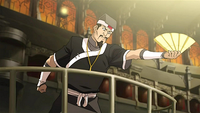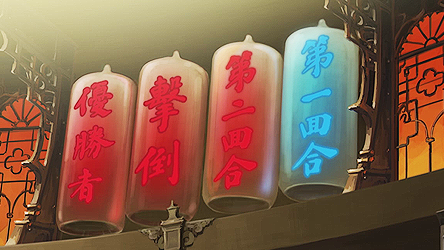Waterbending rules
Each water blast cannot exceed one second in duration, meaning that waterbenders may not use any form of a constant hose-like stream of water against their opponents. Water must be used in its liquid state, not as a gas or a solid, meaning that steam, fog, and ice are prohibited in game play; it cannot be filled with anything, such as earth. Water is the only element for which head strikes are allowed.
Waterbenders can only access water within their zone, specifically from the metal grates directly in front and behind the zone that the player is currently occupying. Water may only be pulled up from the zone lines, and not from any outside sources, such as the water below the ring.
Earthbending rules
Unlike waterbending, no direct earth strikes can be aimed toward an opponent's head. Though the ring is comprised mostly of canvas-covered metal, no
metalbending is permitted. Earthbenders may only bend earth in its raw form, and not as sand or dust.
Earthbenders are restricted to bending regulation rock discs supplied through the floor of the ring, and may only bend discs from their own zone. Rock discs may not be broken down intentionally into smaller pieces, though the bending of several discs at one time is allowed. Players may ricochet or deflect discs off the side ropes, like air hockey.
Firebending rules
Each fire blast must not exceed one second in duration, meaning that firebenders may not use constant flamethrower-like streams of fire against their opponents. No direct fire strikes toward an opponent's head are permitted. Unlike water and earthbenders, firebending pro-benders are not restricted with how they produce their own flames, but are prohibited from using
lightning generation during game play.
Injuries
If any given player sustains an injury during a match, play is halted and the player is removed from the ring; however, injured participants may be permitted to continue if they are still capable. Players who are injured while being knocked off the brink will be rescued by gaming officials.
In both cases, the team must continue the match without a replacement.
Tournament rules
No member of any team in the running for the championship may get into a physical confrontation with another player of an opposing team outside of a pro-bending match. If this occurs, the team that instigated the fight will be ejected from the tournament, and the team they were to battle against will move forward. In addition, a competitor may only compete on one team. In the event the Avatar participates in a pro-bending match, he or she may only bend one element.
Penalties


There are several rule violations that will result in a penalty. Stepping over a line when the proper conditions have not been met, knocking a player off the arena from the sides, and the use of "unnecessary roughness", such as holding a continuous blast of an element against a fighter, will cost the offender a one-zone penalty. In the case of the Avatar, a penalty may be issued if he or she bends anything other than his or her designated element.
In addition, intentionally hitting the referee, the referee stand, or the audience stands with an element is considered a violation. Though they are unlikely to do so, pro-benders are not permitted to hit the roof of the arena with bending.
Players who intentionally break a rule may be shown a yellow fan as a warning. Repeat offenders may receive a red fan after receiving a yellow fan, resulting in their removal from the game. The team that has lost a player must continue without a replacement.
Winning rounds
A round is won by gaining territory before time runs out. If no team has secured opposing territory by the end of the round, the team with the most number of players remaining wins the round. However, if the team with fewer players has gained more territory by the end of the round, they are declared as the winners of that round.
Winning matches
Matches are won by either winning the most rounds or by executing "knockouts". Knockouts are accomplished when all members of an opposing team are knocked off the back of the ring within one round.
Even if a team has won two rounds, they must still play a third round, as a match can end in a knockout at any point.
Tiebreakers

Tiebreakers are fought when a round ends in deadlock.
If a round ends in a deadlock, with neither team gaining territory and having an equal number of players on the field and in each zone, the winner is decided in a tiebreaker "face-off". In a face-off, the referee tosses a coin, and the team that wins the coin toss can decide which player and which element will go into the face-off. Players always face their same element.
The face-off takes place on a raised circular platform in the center of the ring. The tiebreaker platform includes a total of four earth dispensers placed on both sides. In the case of water-based tiebreaker, water grates that run along the perimeter as well as the center are raised along with the platform. Players may use their respective elements, along with grappling, so long as there are no "empty hand strikes", particularly punches to the face or kicks to the stomach. The objective is to knock the opposing pro-bender off the circle. The player who falls off first loses the tiebreaker, and the opposing team wins that given round. If both players fall off the circle simultaneously, the player who lands first (hitting either the ring, ropes or the rink) loses the tiebreaker.
If the referee cannot determine who landed first in the above scenario, a second tiebreaker is held between two other members, using a different element. When each team has won a round and the third ends in a deadlock, a tiebreaker face-off is used to determine which team wins the match.
~Wikipedia

